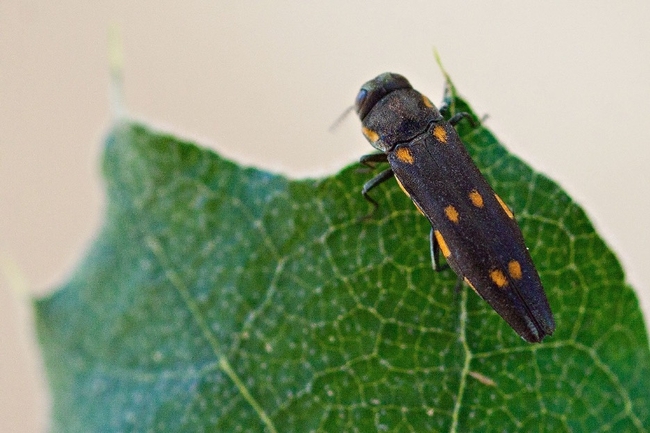There are several flatheaded boring beetles in California, however only a few are of particular concern. The goldspotted oak borer (GSOB), Agrilus auroguttatus, is a metallic wood-boring beetle that threatens our native trees. Since it was introduced to Southern California on contaminated firewood in the early 2000s, this pest has caused extensive damage to woodlands and native oaks.
What does the goldspotted oak borer look like?
Adult GSOB are 0.4 inch long and 0.08 inch wide with bullet-shaped bodies. They are black with an iridescent green sheen and six distinct gold spots on their back.
What damage does the goldspotted oak borer cause?
Goldspotted oak borers only attack oaks (Quercus spp.). They are particularly damaging to coast live oak and California black oak. Adult beetles lay eggs on host trees and the larvae bore into the wood, feeding on the tree's vascular tissue. The larvae feed on the tree until they pupate into adults and exit the tree, leaving D-shaped exit holes in the bark. Extensive GSOB feeding can girdle trees, disrupting water and nutrient uptake and eventually causing the tree to die.
What can you do about the goldspotted oak borer?
Don't move firewood! The most important way to prevent the spread of invasive wood borers like GSOB, is to buy firewood where you're going to burn it. If you live in an area of Southern California where GSOB is present, avoid planting susceptible trees. If you need to remove an infested tree, keep the cut wood away from healthy oaks and tarp or grind the wood to kill any larvae present. To report possible sightings, fill out the Goldspotted Oak Borer Symptoms Reporting Form at https://ucanr.edu/sites/gsobinfo/What_You_Can_Do/Report_GSOB_Symptoms/
To learn more about this invasive pest visit the UC IPM Pest Notes: Goldspotted Oak Borer or the UC ANR Goldspotted Oak Borer page.
